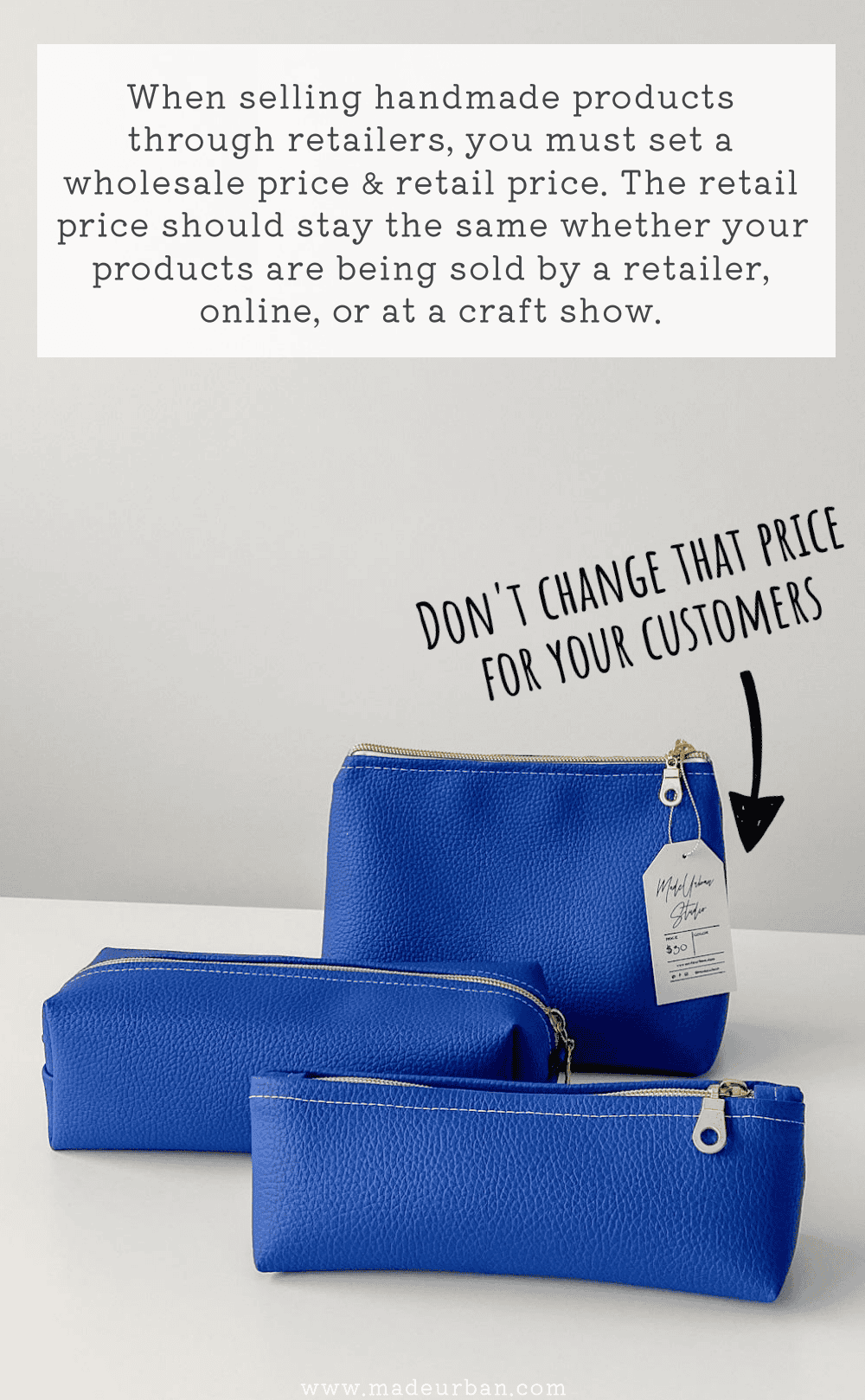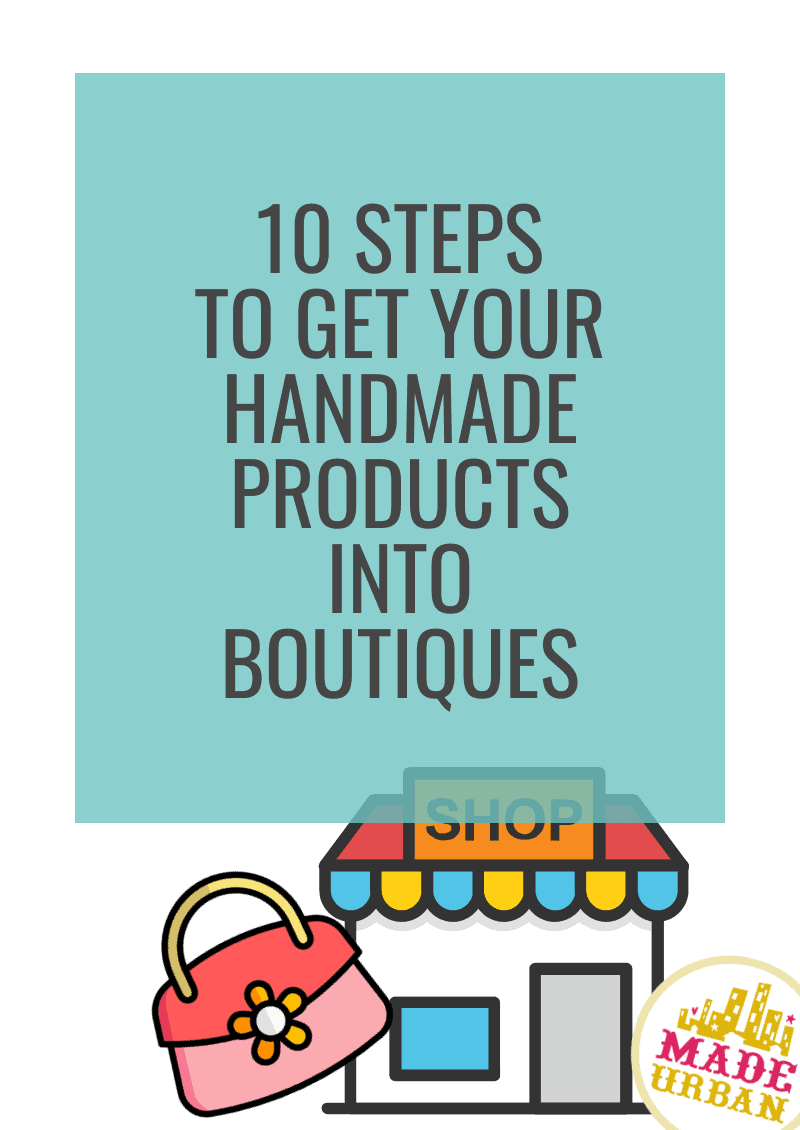10 Steps To Get Your Handmade Products In Boutiques
If you want to expand your reach and get your products into retail stores around your city, province, or even country, you need to make a plan.
Selling wholesale to retailers requires you to know your numbers, be organized, and stay ahead of schedule so you can fulfill orders promptly.
Here are 10 steps to follow to get started!
1) Set your Wholesale prices
Selling at a craft show or online is much different than selling through a retail store. Retailers will pay your wholesale prices, not retail prices.
Typically wholesale prices are half of your retail price. This means when you sell an item at a craft show, you get to keep all the money (that’s listed on the price tag) and after your wages and costs are covered, the rest is profit.
Selling wholesale, you get half that money and the rest goes to the boutique. When you cut your retail price in half, will you still be happy with your profits? If you’re looking at selling through boutiques, you may need to raise your prices across the board.
Here’s a detailed article on pricing: The Right Way to Price a Handmade Product (Step-by-Step Formula)
2) Stick to your prices
It would be unfair to sell your products at a lower price on your website, than boutiques are selling them at. If you decide to raise your prices to make a profit through wholesale orders, you must keep your retail price the same whether you’re marketing to retailers or craft show shoppers.
Let’s say I have a bag that I’ve priced at $50. A retailer placing a wholesale order would likely pay me $25 for that bag. They would then sell it to their customers at $50.
If a shopper sees the bag for $50 in their store, then visits my website and sees it listed at $30, they’re going to buy from me, instead of the retailer (which is unfair to the retailer and they wouldn’t continue doing business with me).
Your retail price should stay the same, no matter which sales channel you use (e.g. craft shows, Etsy, boutiques, etc.).
You can run sales or promotions to offer your shoppers discounts now and then, but your retail price should stay consistent.

3) Wholesale or Consignment?
Decide what type of selling agreement you would like to have with store owners.
Wholesale means the retailer will purchase your products.
Consignment means that you will give the store some stock and they will pay you the wholesale price (or a decided percentage) when an item sells. If a product doesn’t sell (within an agreed-upon time), you take the stock back.
If you’re a new business or are trying to get your products into a popular retailer, a consignment agreement may be more appealing to the retailer. It allows them to test your products in their stores without a monetary investment. Once they have proof that your products are popular with their customers, they may place a wholesale order, which is better for you.
You may also be interested in: Consignment vs. Wholesale (Which is Better?)
4) Set your policies
Define policies that will help ensure a good working relationship with retailers and will protect your business.
Consider:
- Wholesale prices – 50% of the retail price is typical, but if you make a product that has higher or lower costs, you may offer a lower or bigger discount to retailers.
- Minimum retail prices – just as it would be unfair to retailers for you to have retail prices lower than theirs, it would also be unfair for them to set the prices of your products lower than you or their competitors carrying your products. A “minimum retail price” defines the lowest price at which your products can be sold.
- Order minimums – the number of items a retailer must purchase to receive wholesale pricing
- Shipping – who pays for shipping
- Payment terms – when (e.g. Net 30, 60, or 90) and how you expect payments
- Returns/exchanges – whether or not you’ll allow a retailer to return or exchange an item with you, and on what terms. A retailer may have an issue with a product when they receive your shipment, or one of their customers may run into an issue (e.g. a defective item).
If you’re working with a retailer through a consignment agreement, you’ll want to define similar terms (you may be interested in: What to Include in a Consignment Agreement)
5) Get ahead of schedule
Once you’re working with retailers, you have to work with their schedules. Retail buyers will often purchase months ahead of a season. So even though we’re still in flip-flops and shorts, they’re thinking about scarves and hoodies.
You have to think ahead and organization is a must.
Find out when the retailers you want to work with buy for a season. Typically, the bigger the store the further in advance they buy. Most retailers will place orders in July for Christmas stock.
This might mean that you must start planning your holiday product line in May so you have everything ready to market it to retailers in June, so they can place orders in July.
Pitching your Christmas stock to retailers months after they’ve already purchased their stock isn’t a professional look.
You must also look at your schedule to ensure you’ll have time to prep everything and fulfill orders by the time retailers expect to have stock in their stores (they’ll also want that ahead of time). Be sure not to accept more orders than you can fulfill.
6) Research boutiques
Find out which retailers support local vendors and sell handmade goods. If you can, visit their stores to get a feel for them and make sure they’re also a fit for your business/brand/products.
It won’t benefit either of you if your products aren’t a fit for their shoppers.
Create a list of ideal boutiques you could work with in the future.
7) Choose your A-team
From your long list of retailers, choose the top ones you’d love to work with.
Make sure those retailers are spread out in a city and you’re not pitching your products to two retailers who are only a couple blocks away from each other.
Just as you like to be different from other vendors at a craft show, boutiques want to carry unique products that customers visit their store for.
Make sure your list isn’t too big either; you need to be able to fill each of their orders in a timely manner.
8) Create a line sheet (and lookbook)
A line sheet will make it easy for retailers to view your product line and place an order. It should list product names/SKUs, product images, product options, retail prices, wholesale prices, etc. You might also include your wholesale terms, a little business information, and an order sheet or instructions on how to place an order.
You may also want to create a lookbook, which is a more stylized way to present your product collection. This will be key if you can’t bring or send a sampling of your products to the store. Here’s how you can create a lookbook for your products.
9) Set up a meeting
Call and ask who does the buying for the store and if you can speak with them. They may have a dedicated buyer or it may be the store owner who does all the buying (usually the case in smaller boutiques).
When you’re able to talk to them, ask if you can set up a meeting to stop by and show them some of your items.
If you’re not in the same city as the retailer, it’s still a good idea to talk to the buyer/owner on the phone and ask if you can send them a line sheet and lookbook.
It’s always a good idea to follow up to see if they’re interested in placing an order. If they’re not, it’s helpful to gather feedback so you know whether or not to stay in contact with them (you don’t want to waste your time/money sending line sheets each season if your products just aren’t a fit for their customers) and to see if there are any improvements you can make.
10) Stay on the lookout
When you’re on vacation or travelling somewhere new, keep an eye out for retailers that might be a fit. It’s hard to know which areas and stores are trendy when you don’t know the city but you can find out, firsthand when you’re exploring.
Keep the same points in mind; ask if the owner or manager is in, introduce yourself and ask if you can email them about your products once you’re home from your trip. Bonus points if you have a lookbook or business card you can hand out right then and there.


Hey, I’m Erin 🙂 I write about small business and craft show techniques I’ve learned from being a small business owner for almost 2 decades, selling at dozens of craft shows, and earning a diploma in Visual Communication Design. I hope you find my advice helpful!

Great for the business of crafts